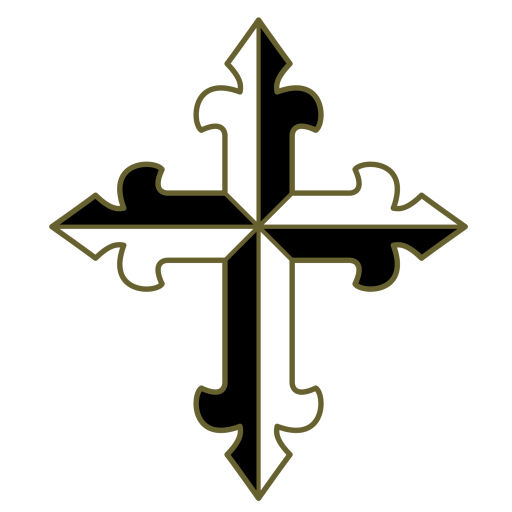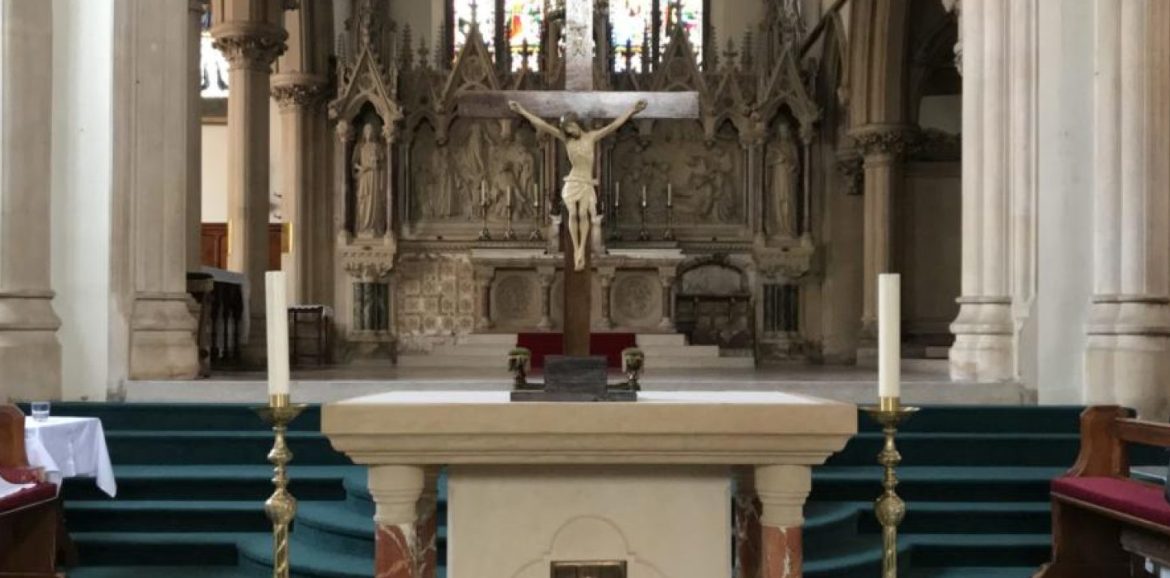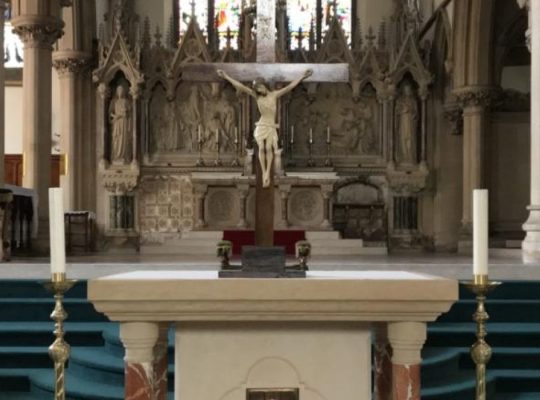‘Alleluia, alleluia, alleluia.’
‘I bring you news of great joy. ALLELUIA! The Lord is risen.’
Thus, the liturgy of Easter Sunday—the last day of the Easter Triduum is celebrated. It is peaceful and serene. One interiorizes and meditates on the good news proclaimed with more exuberance during the night: ‘The splendour of Christ risen from the dead has shone on the people redeemed by his blood’; ‘Our Redeemer has risen from the tomb’; ‘ The Lord is risen as he promised.’ Celebrated in this atmosphere, the Eucharistic thanksgiving on Easter Sunday has a joyful tone which is not really contained, but which rather springs from hearts penetrated with light and wonder, expressed best with simple words: ‘The Lord is risen, alleluia. Glory and kingship be his forever and ever.’ Expressed explicitly the night before in the liturgy of light where the lighted Easter Candle, an icon of the risen Christ is carried into a darkened Church. The procession, led by the elevated Easter Candle evokes the journey of God’s people, led no more by a bright cloud but by the glorious light of Christ that shines on every person coming into the world and which draws ever nearer: ‘Christ our light!—Thanks be to God!’ In a Church lit by tiny flames, kindled from the Easter Candle that is placed high for all to see, rises the longest and most lyrical of liturgical thanksgivings. It sings of ‘the night truly blessed’ ‘when Christians everywhere, washed clean of sin and freed from all defilement, are restored to grace and grow together in holiness’ ‘When Jesus Christ broke the chains of death and rose triumphant from the grave.’ ‘When heaven is wedded to earth and man is reconciled with God.’ The expressions of an eternal thanksgiving come thick and fast—The ‘happy fault, the necessary sin of Adam which gained for us such a great Redeemer’ And, after having declared: ‘Accept this Easter Candle, a flame divided but undimmed, a pillar of fire that glows to the honour of God,’ the chant ends with a prayer— asking that this light will ‘mingle with the lights of heaven’ and continue to burn brightly to ‘Dispel the darkness of this night.’ And we pray that this ‘Flame, this Morning Star’ who is Christ, risen and back from the dead, will ‘shed his peaceful light on all mankind.’
The Easter Proclamation— ‘The Exsultet’—
‘Exult, let them exult the hosts of heaven, exult, let angel ministers of God exult, let the trumpet of salvation sound aloud our mighty kings triumph! Be glad, let earth be glad, as glory floods her, ablaze with light from her eternal king, let all corners of the earth be glad, knowing an end to gloom and darkness. Rejoice let Mother Church also rejoice arrayed with the lightening of his glory, let this holy building shake with joy, filled with the mighty voices of the peoples Therefore, dearest friends, standing in the awesome glory of this holy light invoke with me I ask you, the mercy of God Almighty…….. For it is truly right and just, with ardent love of mind and heart and with devoted service of our voice, to acclaim our God invisible, the almighty Father, and Jesus Christ, our Lord his Son, his Only begotten. Who for our sake paid Adam’s debt to the eternal Father, and pouring out his own dear blood, wiped clean the record of our ancient sinfulness. These then, are the feasts of Passover, in which is slain the Lamb, the one true Lamb, whose blood anoints the doorposts of believers. This is the night, when once you led our forebears, Israel’s children, from slavery in Egypt and made them pass dry shod through the Red Sea. This is the night that with a pillar of fire banished the darkness of sin. This is the night that even now, throughout the world, sets Christian believers apart from worldly vices and from the gloom of sin, leading them to grace and joining them to his holy ones. This is the night, when Christ broke the prison bars of death and rose victorious from the underworld. Our birth would have been no gain had we not been redeemed. O wonder of your humble care for us! O love, O charity beyond all telling, to ransom a slave you gave away your Son! O truly necessary sin of Adam, destroyed completely by the death of Christ! O happy fault that earned so great, so glorious a Redeemer! O truly blessed night, worthy alone to know the time and hour when Christ rose from the underworld! This is the night of which it is written: the night shall be as bright as day, dazzling is the night for me, and full of gladness. The sanctifying power of this night dispels wickedness, washes faults away, restores innocence to the fallen, and joy to mourners, drives out hatred, fosters concord, and brings down the mighty. On this your night of grace, O holy Father, accept this candle, a solemn offering, the work of bees and of your servants hands, an evening sacrifice of praise, this gift from your most holy Church. But now we know the praises of this pillar, which glowing fire ignites for God’s honour, a fire into many flames divided, but never dimmed by sharing of its light, for it is fed by melting wax, drawn out by mother bees to build a torch so precious. O truly blessed night, when things of heaven are wed to those of earth, and divine to the human. Therefore, Lord, we pray you, that this candle hallowed to the honour of your name, may persevere undimmed, to overcome the darkness of this night. Receive it as a pleasing fragrance, and let it mingle with the lights of heaven. May this flame be found still burning by the Morning Star: the one Morning Star who never sets, Christ your Son, who, coming back from deaths domain, has shed his peaceful light on humanity and lives and reigns forever and ever. Amen’
Listening to this wonderful chant, one can understand why the Easter Candle is lit at every baptism; so it should also be obvious why it will still be burning at one’s funeral, the passage from death to life, with Christ. It is a symbol of the risen Christ and the love that he has for us.
We now turn to John’s account of finding the empty tomb ‘on the first day of the week…early in the morning. John deals more quickly than the others with the discovery by Mary Magdalene and her companions. Their first thought is that Jesus’ body has been taken away and put they know not where. The evangelist says that Mary Magdalene hurried right away to tell this to Peter and ‘to the other disciple whom Jesus loved,’ an expression that refers to John himself. Right away, this suggests that the apostles, with Peter at their head, are the proper witnesses of the resurrection. ‘So Peter and the other disciple went out and came to the tomb. They both ran, but the other disciple ran faster than Peter and arrived at the tomb first.’ However, he does not enter, but waits for Peter and lets him go in first, recognizing his primacy.
Bending down, he can see ‘the burial clothes there.’ Peter, entering the tomb dug out of the hillside, sees both this and, that ‘the cloth that had covered his head’ is there, ‘not with the burial cloths but rolled up in a separate place.’ Clearly the body has not been stolen. The empty tomb, which itself proves nothing, is thus clearly to be seen as a sign that hints at what has happened. John immediately goes from the appearance of the sign to faith in the reality it points to: ‘He saw and he believed.’
This is a wonderful formula. Certain things—water changed into wine as at Cana, cures, lance thrusts into a dead body, an empty tomb with shroud and veil neatly rolled up—everyone can see these things. To recognise them as ‘signs’ requires an understanding informed by faith. It is attained when one sees and confesses the supernatural reality that God has wished to reveal to human eyes without dazzling them with too sudden and strong a light. John, more than anyone else, has developed this theology of signs that are indispensable for faith but do not coerce it. John wants us to understand the interaction between ‘signs’ and Scripture. The latter allows one to understand the signs that in turn lead to an understanding of Scripture. If the disciples had not ‘known’ through Scripture that Jesus must rise from the dead, the empty tomb would have remained an unsolved puzzle. But conversely, the ‘sign’ of the empty tomb led them to a full knowledge of Scripture. Such is always the case.
Finally, this Gospel offers a reflection on the complementary nature of love and authority in the Church, ‘Love one another as I have loved you.’ The question must be dealt with very carefully, and todays Gospel is a valuable guide. ‘The disciple whom Jesus loved’ arrives at the tomb first, but he gives way to Peter, the leader of the apostles, not arrogating any right to himself, from the fact that he believed immediately. The true saints, despite their profound conviction rooted in a particular ‘vision’ or ‘revelation,’ have never tried to overthrow those who have been given authority in the Church, but out of love have acceded to their authority.
The Lord’s resurrection is the supreme blessing for all believers. Every man and woman—each according to grace, charism, and ministry—must announce it to the whole world—’Exult….. For this is the night, when Christ broke the prison bars of death and rose victorious from the underworld.’
‘Alleluia, alleluia, alleluia. I bring you news of great joy — Alleluia. The Lord is Risen.’
HAPPY EASTER!


